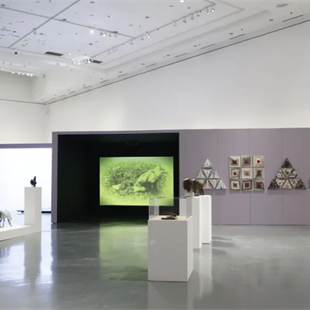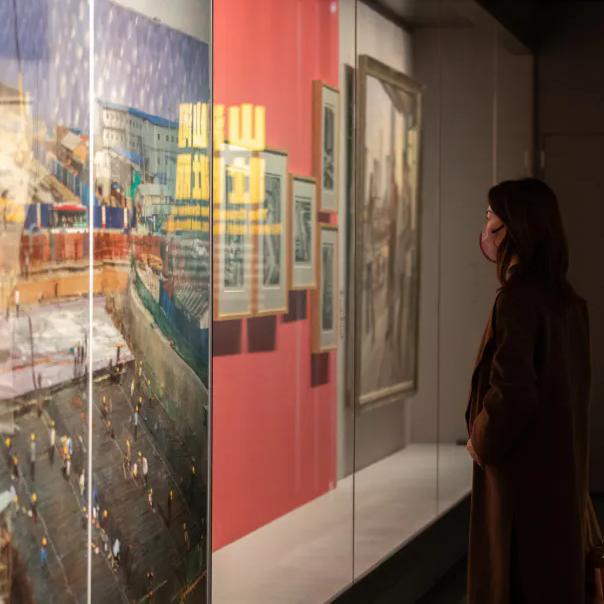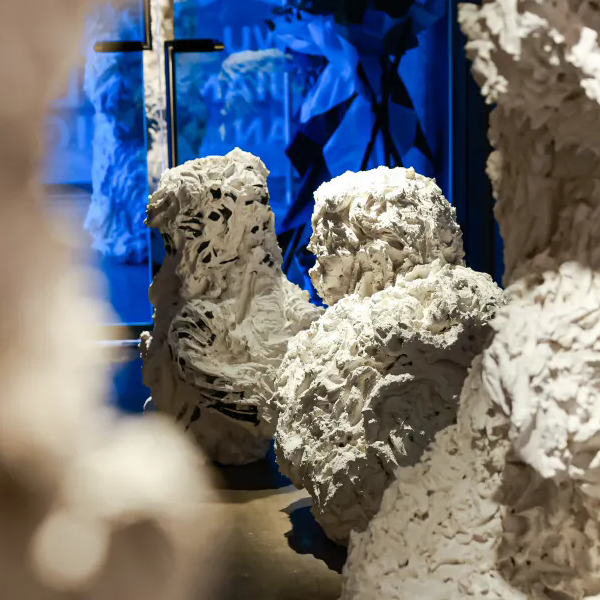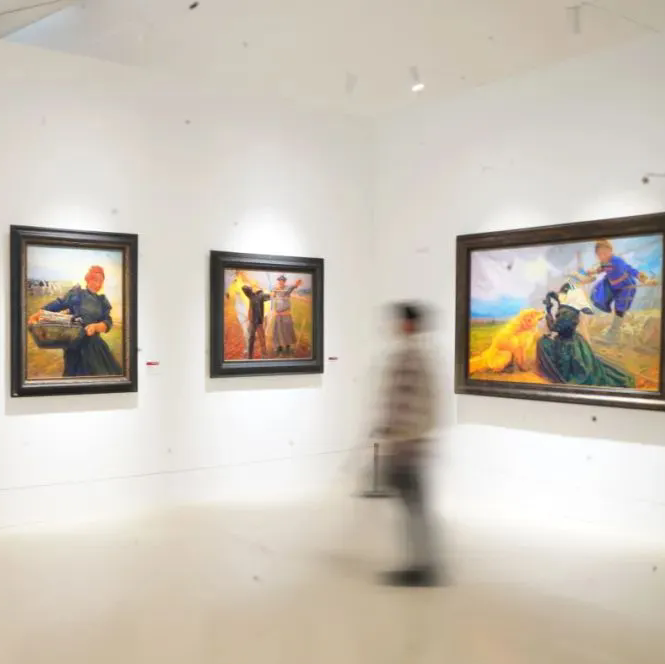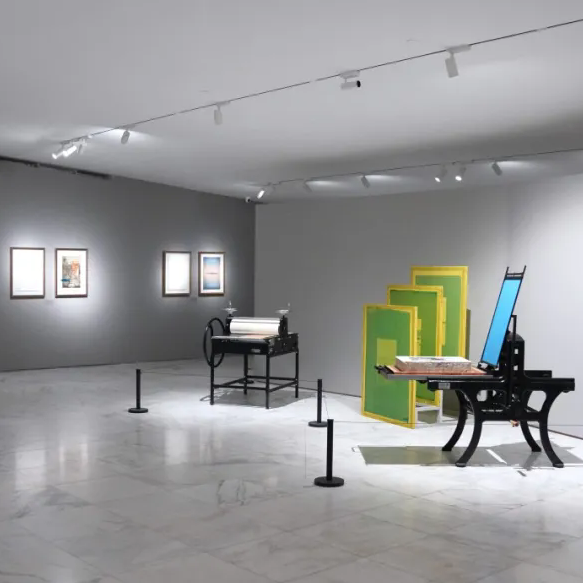
A biennale is one of the most influential forms of international art exhibition and is an opportunity to present the spirit of the city in which it is hosted. As an international, cultural and academic event held on a large scale, it is an ideal platform for exchanging artistic ideas and displaying the latest achievements and innovations of art – both local and global. A large-scale, high-quality biennale of this sort is also an opportunity for the city in which it is hosted: to boost its economy, nurture its art and culture, develop its infrastructure and strengthen its ties with the international community.
Chengdu occupies an important position in China’s general development strategy. Along with Chongqing, it is a part of the southwest’s “Twin City Economic Circle” and as such plays an important role in China’s plans for high-quality development in leading zones and advancing new urban construction, as well as the One Belt One Road Initiative. Chengdu is the site of a new development project based on the concept of the “Garden City”, an attempt to explore means of sustainable urban development in the new era. This project prioritizes the environment and green development, as well as building a city that is centered around its inhabitants. As a new model for the Garden City, Chengdu will bring the urban, the human and the natural into harmony with one another, establishing a new urban environment that encapsulates diverse cultures and realizes the ideal of the future city. Chengdu is a city with its own special character: old architecture adjoins new districts, leisure accompanies enterprise, old traditions encounter the latest fashions, and the local interacts with the international. As such it is a vibrant and eclectic city, a super-fusion of multiple dimensions, fields and levels. It is a source of great inspiration for artists and provides fertile land for a large-scale art exhibition.
Since its conception, the Chengdu Biennale has always sought to support and foster Chinese art with a view to exploring the cultural and historical context behind contemporary artistic production, presenting the current status of Chinese art, and helping Chinese artworks attain international status among the artistic community and society more broadly. However, with the arrival of the new era, the Chengdu Biennale has taken on a new mission. The aim of this year’s Biennale is to realise the spirit of the fifth plenary session of the Nineteenth Central Committee of the Communist Party of China. The year that China’s Fourteenth Five-Year Plan is put into action will see two new art galleries open in Chengdu, with the Chengdu Biennale showcasing the latest achievements of the city’s cultural sector. Based on the new development stage, embodying the principles of new development, establishing a new development order and guided by the doctrine of high-quality development, the exhibitions will act as a cultural cornerstone, collecting outstanding art – with an emphasis on new works – from China and abroad under the concept of “Art Blooms in Garden City” thus satisfying the people’s growing need for beauty and culture, and contributing to Chengdu’s cultural infrastructure and high-quality development.
The world has entered a new era in which previous orders and systems no longer hold, and great changes are taking place in the fields of politics, economics, culture and ecology. The fates of people the world over have never been so intimately interconnected. The age in which we live calls for greater dialogue and co-operation between us all, a new system of cultural values that inspires hope. Contemporary art provides precisely the kind of spiritual support humanity needs in such a challenging period of crisis. It is for this reason that the 2021 Chengdu Biennale has chosen Super Fusion for its theme, in the hope that bringing together the global and the local, the urban and the spiritual, the conceptual and the technical, the fashionable and the innovative, the ecological and the esthetic, the traditional and the avant-garde, and uniting these within the form of the art exhibition, we are able to create a super-fusion of ideas and a space for communication that acts across various disciplines and multiple dimensions. The Biennale hopes to build an esthetic home in the ecological space of the Garden City, to open new paths for artistic exploration, and to present the potential for the mutual flourishing of the urban and esthetic.
As a vast artistic event, the Biennale consists of eight themed exhibitions and one international conference of gallery directors, which are entitled Polymorphic Co-Existence, Urban Co-Habitation, Technological Co-Respondence, Zeitgeist Co-Evolution, Ecological Co-Development, Craft Co-Operation, Ethnic Co-Creation, Artistic Co-Inspiration and Future Co-Conception. The Biennale will feature works from more than 270 artists or artistic groups. We believe that “Art Blooms in Garden City – Super Fusion” provides both an opportunity to encounter an important cross-section of international contemporary art and a profound insight into important cultural questions facing humanity. Under the conditions of a world struggling against the COVID pandemic, and China’s approach to managing the crisis in particular, the Chengdu Biennale embodies the vitality of artistic and infrastructural development in China’s cities and will bring the world’s gaze to focus upon China’s cultural confidence and inclusivity.
Chief Curator: Fan Di'an
Fan Di’an is the President of China Central Academy of Fine Arts. He is the chairman of China Artists Association, the chairman of Beijing Artists Association,and the deputy director of Art Education Committee at Ministry of Education. Fan has long been interested in twentieth-century Chinese art, contemporary art criticism, curating and museology. He has published numerous essays on art and art criticism, curated hundreds of academic exhibitions that reflected the timely progressions and developments of Chinese art.
Academic Committee Director: Lu Peng
Art historian, art critic and curator. He currently works at the Sichuan Fine Arts Institute as professor and master’s degree supervisor, and as a professor in the Macau University of Science and Technology. He has been associate secretary-general of the Sichuan Theatre Association, editor-in-chief of Art-Market magazine, art chair of the Guangzhou Biennale, art and humanities associate professor at the China Academy of Art, director of the Museum of Contemporary Art Chengdu, art director of the Yinchuan Museum of Contemporary Art and head of L-Art University.
Curators:
Fan Di’an, Lu Peng, Zhang Zikang, QiuZhijie, Yang Wei, Ji Shaofeng, FANG Zhenning, Han Tao, Jeffrey Shaw, Ji Yujie, Zhou Bo, Wang Shaoqiang, JiaYunbo, He Guiyan, Li Keke, Wu Hongliang, Xue Jiang, Wang Chunchen
Exhibition Academic Committee:
Fan Di’an, He Guiyan, Ji Shaofeng, Lu Peng, LIU Jiakun, LYU Pinjing, Li Qingke, Qiu Zhijie, Song Xiewei, Su Xinping, Wang Chunchen, Wang Huangsheng, Wang Mingxian, Wang Shaoqiang, Wu Hongliang, Yang Wei, Zhang Zikang
* Brief Introductions to Eight Themed Exhibitions
Polymorphic Co-Existence
Curators: Fan Di'an, Lu Peng, Zhang Zikang, Qiu Zhijie, Yang Wei, Ji Shaofeng
Location: Gallery B1/B2/B3, 1F, District B, Chengdu Art Museum (Chengdu Museum of Contemporary Art)
Artists: Anish Kapoor (UK), Olafur Eliasson (Islandia-Dinamarca), Zeng Fanzhi, David Rokeby (Canada), Daniel Buren (France), Fan Bo, Fito Segrera(Colombia), Fu Zhongwang, He Duoling, He Gong, Gabriel Lester (Nederland), YU BOU CHIANG, Carsten Höller (Belgium), Katharina Grosse (Germany), Leandro Erlich (Argentina), Li Fan, Li Qiang, Liu Gang, Meng Luding, Song Dong, Su Xinping, Tan Xun, Tang Jie, Tony Cragg (UK), Wang Yigang, Wang Yuyang, Xu Bing, DO HO SUH (South Korea), Xu Longsen, Ava Hsueh, Yang Qian, Yi Chengtao, Yoan Capote (Cuba), Zhang Dali, Zhang Haichao, Zhang Lujiang, Zhang Xiaotao, Zhang Xiaogang, Zhou Chunya
“The gentleman harmonizes but walks his own path.” This quote from Confucius reflects the extent to which diversity was held in high regard by classical Chinese thinkers. In the present day, with the world witnessing transformations of a sort not seen in the last century, this ancient wisdom seems more pertinent than ever. The philosophy of the exhibitions in this Biennale is precisely one of accentuating the harmonious co-existence of diverse cultures and emphasizing art’s role in establishing a collective consciousness among peoples in society and living things in nature. “Polymorphism” refers to the way in which a rich range of artistic modes and approaches are realized across a variety of dimensions – nation state, ethnic group, geographical region – and how this process is in a state of constant flux. The manner in which these various cultural movements live alongside one another, adapt to one another, communicate with one another and rely upon one another is reflected in the name “Co-Existence.” It is a way of life, a way of viewing the world in its broader aspect.
The fluid and interconnected nature of art in all its variety is the concept behind Polymorphic Co-Existence. 39 artists from twelve countries – China, the United Kingdom, France, Germany, Belgium, the Netherlands, Iceland, Canada, South Korea, Argentina, Colombia and Cuba – have been invited to provide their latest work for the exhibition; work that touches upon a range of subjects such as philosophy, society, life, media, information, space and time, and takes on such various forms as installation, photography, painting and sculpture. The exhibition hall provides a space in which these artworks are able to encounter and enter into dialogue with one another, thereby forming a polymorphic matrix of esthetic interrelations and producing new kinds of cultural understanding and collective knowledge.
As well as exploring the myriad possibilities for future cultural development, Polymorphic Co-Existence not only reflects the vitality of artistic thought and technical ingenuity, but also the potential for collective thinking – both among peoples in society and among living things in nature. It pays testament to the polymorphic nature of contemporary art, the power of harmonious and eclectic co-existence to produce new forms of beauty.
Urban Co-Habitation
Curators: FANG Zhenning, Han Tao
Location: Gallery B7/B8, -1F, District B, Chengdu Art Museum (Chengdu Museum of Contemporary Art)
Artists: Chen Wenji, FANG Zhenning, HU ANG+TOD URBAN DEVELOPMENT INSTITUTE, HuQian | ISOZAKI+ HuQian Partners, LI Hu + HUANG Wenjing | OPEN, LIU Jiakun, Tanghua Architect & Associates, People' s Architecture Office | HE Zhe+James, Shen+ZANG Feng, ZHU Jingxiang, Zhu Pei, Shigeru Moroizumi, MAD Architects | Ma Yansong+Dang Qun+Yosuke Hayano, AZL ARCHITECTS, FANGmedia, Fanzhu Design, HanTao+GuoXi+HeZiMing / Thanlab Office, Han Wenqiang | Archstudio, Hu Zheng | Jing Studio (CCDI), Huang Zelin · Aether Architects, SpaceStation, Atelier Lai | Madao, LUOstudio, LYU Pinjing, SHANSHAN QI / STUDIO QI ARCHITECTS, Horizontal Design, Sun Dayong and Wan Shuyan/Penda China, OnEartharch Architect, HAI WANG, Shimu Wang, Vector Architects, Design by Zhou Zishu & Digua, fabersociety | Zuo Long, MUDA-Architects, Taolei Beijing Architectural Design Co., Ltd., BIG, Gregory Orekhov, NAICE architecture and design, REgroup, Valerio Olgiati, Liu Yi/ China Southwest Architectural Design And Research Insitiute, Chengdu Metro City Investment Group Co., Ltd.
Concerning the beauty of Chengdu, Pan Yue, a writer of the Western Jin Dynasty, famously remarked in his Ode to Orange, “While Jiangling (nowadays Jingzhou) is dignified for its dense forests, Chengdu’s beauty lies in its graceful gardens.” Down the age of mankind, the word home often brings about collective and personal memories. Home, in Chinese, is translated as "Jia-Yuan", originally meaning “the garden in the dwelling place”; it now refers to the household or the homeland in general. Or you can say the word home may either refer to an ordinary garden or a distant hometown depending on where you are. And many stories, a miscellaneous collection of joy and sorrow, are built around home: a traveling youth pines for home, or an old man enjoys the happiness of family at home. Preserved in the word “home” are the whispers between man and nature as well as the wanderings in dreams.
Through the progress of civilization, the word “home” has acquired much more meaning than just “an individual household” or “a local village”. Instead, it inadvertently developed into a synonym for the mankind community with a shared future, the globe that all creatures dwell on. So we raise the concept of Homeland Co-Inhabitation, which presents the system of mutualism, a positive, inseparable association formed between members of two different species that interact to each other's benefit, cooperate with each other, and live together.
We humans are also a member of the earth's ecological circle, and we must establish a mutualistic relationship with animals, plants, and fungi. Our behaviors, our designs, and our constructions must be grounded on the assumption that all creatures on earth can live together. The mutually dependent and beneficial relationship is exactly what " Urban Co-Habitation " represents.
The section of Urban Co-Habitation invites 41 artists and designers to focus on the interwoven relationship between architecture, art and the city in the modernization process through the exhibition of 90 pieces/groups of works. From heritage protection to urban renewal, from community culture to landscape architecture, from urban function to smart life, architectural design and artistic creation continuously intervene into urban space, awaken urban functions, and play a key role in transforming and improving ecological, spatial, culture, and visual environments, hence a beautiful cohabiting home for mankind and other creatures.
Technological Co-Respondence
Curators: Qiu Zhijie, Jeffery Shaw
Location: Gallery A5/A6/A7/A8, 2F, District A, Chengdu Art Museum (Chengdu Tianfu Art Museum)
Artists: Evelina Domnitch (Belarus) & Dmitry Gelfand (Russia), Bai Xiaomo, Chen Baoyang, Haroon Mirza & Jack Jelfs (UK), He Xuan, Huang Jieyuan, Jim Campbell (USA), Shinseungback Kimyonghun (South Korea), Coralie Vogelaar (Nederland), Laurent Grasso (France), Liam Young (Australia), Lea Porsag er (Denmark), Lynn Hershman Leeson (USA), Lin Xin, Long Xingru & Zhou Tiange, Echo Can Luo, Marc Lee (Switzerland), Michael Frei (Switzerland), MYStudio (Anna Borou Yu / Jiajian Min), June Balthazard & Pierre Pauze (France), Qiu Siyao, Reva, Jeffery Shaw (Australia), Sun Yuqian, Tamas Waliczky (Hungary), Tan Bin, Wu Fan & Wang HancaiWu Ziyang, Zhang Congcong, Zhang Zhejun&Cai Hongpeng&Yu Chengfeng, Zheng Da
The idea that a certain affinity exists between the world and humankind has been a part of Chinese culture for millennia. In fact, variations on the notion that the microcosm of human activity and the macrocosm of the universe are connected in some way are discernible in the myths and philosophical sayings from many ancient civilizations, such as Egypt, India and Greece. In ancient times, people in China were aware of a certain manner in which the myriad entities of the cosmos responded to one another. They called this phenomenon the Dao or the Way.
With the arrival of mechanical thinking, the world began to reveal itself as an intricate watch in which every future event was already prefigured in the interlinked motion of its innumerable cogs. The meticulously designed and elaborately constructed watch of the universe proceeds with perfect precision. In the same way, the human body also resembles an elaborate watch, as do the cities we inhabit.
Traces of this holistic view of the world appear in contemporary systems theory. A butterfly flaps its wings in South America and causes a storm in the Pacific Ocean. How is it that a tiny fluctuation in the cosmic microwave background picked up by a radiometer can spark a neural connection light years away in somebody’s brain?
Technological Co-Respondence will exhibit works from the field of technology-inspired art by 32 artists/groups from a range of countries, such as China, Switzerland, Germany, Austria, the USA, Australia, France, the Netherlands, South Korea, Russia and Belarus etc. Divided into four sections – Body, Ecology, Signal, Cosmos – the exhibition will take place over four gallery halls on the second floor of the Tianfu Gallery, where it will explore the ways in which people, cities, geography and digital information systems interact and exchange information with one another. The exhibit hopes to present the mutual correspondence between human thought and the laws embedded deep in the cosmos: the deep resonances between matter, energy and information.In the Age of Enlightenment, we thought that everything was governed by order. The world became transparent. There would be no more secrets concealed within it to surprise us. Today, we have turned our attention to the human brain and discovered it contains a mystery as profound as the cosmos itself. The unknown continues to envelop us. Science is still an art that relies on imagination.
Zeitgeist Co-Evolution
Curtors: Ji Yujie, Zhou Bo
Location: Gallery B4/B5B/B6, 3F, District B, Chengdu Art Museum (Chengdu Museum of Contemporary Art)
Artists: 4aC Design, Cao Fei, Chen Fenwan, Helen Marten (UK), He Xiangyu, Jian Ce, Jiang Ruiying, Jiao Yang, Jiao Yang, Kaws (USA), Teppei Kaneuji (Japan), Dream Catcher Li Yang, Liu Di, Lu Liang, Lu Yang, Ma Qiusha, Fansack, Song Kun, Sun Bo, Tian Xiaolei, Wang Xiaofu, Wang Chang, Wen Ling, Wu Jian’an, Wu Zheren, Xu Zhen, Xander Zhou, Alex Da Corte (USA), Zou You
The thriving world of business and consumerism that is the modern city serves as the backdrop against which new trends in fashion and design develop, and also provides fertile ground for contemporary art. With the arrival of cubism came greater opportunities for artists to interact with commercial art and popular culture in terms of both thought and practice, a trend that resulted in pop art and postmodern art, both powerful affirmations of the dynamism of fashion and design in the modern artistic context. In a time when everyone is an artist, when any human act can be considered art, all that is solid is bound to melt into air.
As a mechanism of capital, commerce has always been a part of modernism, and consumerism is now a vital component of postmodernism. Popular culture and the mass appeal of commercial art are the visual manifestation of capital, which encapsulates fashion, design, cultural trends and sections of contemporary art. Hui Neng once said, "The Dharma is in the world, and never separates from the world." Although fashion and design naturally crave breaking the hedging-in trend with a pioneering gesture, the establishment of which, however, is always signposted by backtracking into a trend. While contemporary art struggles to break free of its inherent boundaries and limitations, it always returns to the material environment and the soil of consumer society. Perhaps the profound introspection sits precisely in the common life.
The "Zeitgeist Co-Evolution" section is composed of the works of 28 domestic and foreign artists. Various media including images, fashion clothing, illustrations, conceptual design, paintings, installations, and sculptures are intended to present the symbiotic relations and interactions between contemporary art, fashion and design. That contemporary art is reborn and renewed in the context of fashion and design is also an aspect of relevancy in global context.
Ecological Co-Development
Curators: Wang Shaoqiang, Jia Yunbo
Location: GalleryA3/A4, 1F, District A, Chengdu Art Museum (Chengdu Tianfu Art Museum)
Artists: AMKK (Japan), Elias Sime (Ethiopia), Diana Scherer (Germany), Gao Yang, Gilberto Esparza (Mexico), Jin Lipeng, Caio Reisewitz (Brazil), Li Jinghu, Liu Bolin, Liu Jiayu, Liu Mingxin, Long Pan, Luo Min, Ma Hongjin, Nnenna Okore (USA), Qi Lan, Ren Zhitian, Shi Zhiying, Shi Ziyuan, Tong Wenmin, Yu Tianyi, Zhang Tianyi, Zhao Renhui (Singapore)
Art all over the world has seen an increasing focus on ecological questions. The relation between humanity and nature is the object of such ecological art’s concern, research and esthetic experimentation. With recent advances in technology, scientific knowledge about the environment has been incorporated into ecological art, while in the cultural sphere, artists have attempted to present imaginative, creative and effective solutions to the question of sustainable development that span academic disciplines. At the same time, ecological artists call for collective participation and social praxis, championing ecological philosophies by way of their artistic practices with a view to bolstering our society’s collective ecological consciousness.
The environment has become an issue that all humanity faces. Global warming, environmental pollution, limited energy sources and mass extinction are all ecological crises that threaten our very way of life. The COVID pandemic that began at the end of 2019 was a reminder of the possibility of natural disasters that can affect the whole planet. We must be able to engage with such problems that affect the entire human species collectively, joining forces to address and survive the crisis we all face.
Ecological Co-Development brings ecological art from an international context together with more locally inflected work from Chengdu artists. As well as 16 Chinese artists, artists from Japan, Singapore, Nigeria, Ethiopia, Mexico and the Netherlands have been invited to participate, with a view to establishing a space for cross-cultural reflection on the question of the environment. The aim is to create a context for exploring ecological questions here in Chengdu, to promote ecological culture through artistic practice, and to provide a Chinese perspective on the ecological question.
Craft Co-Operation
Curators: He Guiyan, Li Keke
Location: Gallery A1/A2, 1F, District A, Chengdu Art Museum (Chengdu Tianfu Art Museum)
Artists: Bai Ming, Cao Hui, Chen Qiulin, Chen Yufan & Chen Yujun, Shinji Ohmaki (Japan), Deng Le, Jiang Ji’an, JUJUWANG (USA), Kathrin von Rechenberg (Germany), Li Changlong, Li Hongbo, Liang Shaoji, Lin Yan (USA), Liu Jianhua, Meng Baishen, Chusak Srikwan (Thailand), Shi Jinsong, Song Hongquan, Song Xin (USA), Tang Zhiyi, Wang Lei, Wang Yunpeng, Wang Zhiou, Wu Junyong, Xiao Yao, Xiao Yu, Zhu Legeng, Zeng Yang
How we regard from a global perspective the way in which traditional culture reinvents itself is an important question for the current age. A synchronic element of the contemporary cultural landscape, traditional culture adapts to the era, engages with the world around it, but remains rooted in local needs and desires.
Chinese traditional culture is at root a visual manifestation of the values and esthetic ideas of the Chinese people that have developed over history and been passed on from generation to generation. This protean process speaks to the question of cultural identity in art in the global age – the dichotomies of globalization and ethnicity, mainstream culture and local knowledge. In his scientific encyclopedia “The Exploitation of the Works of Nature”, the Ming dynasty thinker Song Yingxing writes, “Methods must change with the times,” something that is no less the case for local crafts and artistic techniques. The story of the evolution of traditional practices is not merely linear, historical, a question of the relationship between objects and tools. It also touches upon questions of affinity and interaction between cultures, places and peoples; it is a process that is inextricably linked with society, economy, culture, technology, nature and ecology. Each element is connected synchronically and the whole progresses and unfolds in a local context. To reflect on such work from a global, communal perspective, to emphasize the need for innovation that does not discard the past, to unearth the ways of thinking, cultural spirit and distinctive techniques embedded in the Chinese artistic tradition, is to demand a new form of creativity that spans ages – to unite the past and the present, to bring together a variety of cultures.
Craft Co-Operation will exhibit works from 29 artists from China and abroad, focusing on how old cultures are activated, how historical crafts are passed on from generation to generation, and how traditional practices continue to innovate. By regarding local traditions from a global perspective, we are able to allow traditional crafts to be reborn in a contemporary context. In order to approach traditional crafts conceptually, to establish a genuine link between local culture and contemporary art, we must build a space in which the language of creation touches upon current cultural questions. What we achieve today is only possible because we are able to stand on the shoulders of the giants of the past. The exhibition hopes to address the various phenomena, transformations and applications of present-day society in order to explore the state of contemporary visual culture, to bring together modern thinking, historical culture and local crafts, with a view to constructing a cultural language that resonates with the contemporary social situation.
Ethnic Co-Creation
Curators: Wu Hongliang, Xue Jiang
Location: Gallery A9/A10, -1F, District A, Chengdu Art Museum (Chengdu Tianfu Art Museum)
Artists: Bama Zhaxi, Penpa, Tsering Namgyal, Dedrun, GaDe, Han Shuli, Huang Runsheng, Li Qingke, Li Xinjian, Liu Shangying, Ma Lin, Tian Liming, Wang Bing, Wu Changjiang, Xiong Wenyun, Yang Yueluan, Yu Xiaodong, Yuan Wu, Zang Yuejun, Zhang Huan
The diversity of art secures its role as an unbiased mirror of the world. Nourished by the diversity of, and interface between ethnic cultures, Chinese civilization thrives and flourishes. Sichuan, a hub of multi-ethnic groups with Chengdu as its center, has proved, both historically and currently, to be a melting pot in which diverse cultures meet, compete, interact, and integrate.
Since the peaceful liberation of Tibet, the completion of Sichuan-Tibet highway and other historical process, Chengdu has been one of the major cities that prompt Sino-Tibetan communication. Walking along the highway and bearing the topic of Ethnic Co-Creation in mind, artists have recorded this grand cultural exchange with their works, which, with their roots in diverse ethnic cultures, have conversely become importantly driving forces for the development of Chinese art.
While focusing on the new forms and trends of contemporary art, the Chengdu biennale also concerns the linkage between Sichuan and other regions, observes the co-creation under Ethnic themes, especially the theme of multinational cultural exchange. It aims to represent the so-far unmentioned, or disregarded thread of the development of contemporary Chinese art.
Artistic Co-Inspiration
Curators: Lu Peng, Wang Chunchen
Location: Gallery A11/A12/A13/A14/A15/A16,-1F, District A, Chengdu Art Museum (Chengdu Tianfu Art Museum)
Artists: Alexei Sokolov Konstantinovich (Russia), Alexei Sokolov (Russia), Alexei Sokolov Leonid (Russia), Eric Pasino (Italy), Annalisa Pascai Saiu (Italy), Shigekazu Sakai (Japan), Billy Bagilhole (UK), Chen Xi, Chen Xiaoyang, Deng Qiang, Gu Yue, Guan Huaibin, Guo Tao, Yoshinobu Nochika (Japan), Chiara Vitali (Italy), Jiao Xingtao, Jeremy Gardiner (UK), Jin Rilong, Cosima Bucarelli (Switzerland), Laura Yuile (UK), Li Sui, Li Xiangqun, Liam Walker (UK), Liu Peng (Australia), Liu Qianyi (Japan), Liu Qing, Lorenzo Brivio (Italy), Marie Glaize (France), Maria Giovanna Sodero (Italy), Mei Jian, Mirko Andreoli (Italy), Nicloas Floc'h (France), Daigo Ushi (Japan), Pang Maokun, Pei Li, Song Gewen, Wang Lan,Wei Guangqing, Woonhae Yea (South Korea), Wu Weiming, Nishimura Yusuke (Japan), Tsuyoshi Ozawa (Japan), Xu Qi, Alex Fanelli (Italy), Alexis Chrun (France), Yang Chen, Ian Gouldstone (UK-USA), Yu Chunna, Yuan Yue (France), Zajarula Garani Tassini (Italy), Zhan Wang, Zhang Zhaoying, Zha Rui, Kazumi Nakamura (Japan), Zhu Jinhui, Zhu Tian (UK), Zhu Xi
The world as a whole needs art, which represents the significance and value of life by gathering scattered threads of history and future at one point. Art is lofty, intricate, and penetrating; it stands out as an embodiment of the human spirit, reproduces the twists and turns that humanity has undergone, and pierces through the heavy mist of history.
Art transcends concrete forms, mirrors and echoes the essence and richness of the world. It washes away boundaries of both geographic as well as imagined borders we build in our minds to imprison ourselves, bringing forth the brilliance of the world. The scattered threads of past and present tie in the practice of art, even tighter, for the shared cultural and artistic heritage. The loneliness and dullness of the world fade when art begins to assert itself through meditation and communication, in private or in public. Nowadays, higher education of art has reformed profoundly. Affirming the vision as the key to, and the ideas as the root of contemporary art, it reexamines the fruits of civilizations to draw inspiration and develops the perceptions of the natural and social scenes through daily interactions. Higher art academies now have a mission in common: to create magnificent and enduring artworks for the world and mankind.
This section brings 57 artist-teachers from the higher art academies of China, Britain, France, Italy, Russia, Japan, and other countries, exhibiting over 100 pieces (groups) of artworks. The works of these artist-teachers reflect the zeitgeist, diversity, and thoughtfulness of contemporary Chinese and foreign art education. Simultaneously unveiled in this section, they convincingly sketch contours and trends of contemporary art education and bring past time together with present time and with visions of the future.
About Chengdu Art Museum

Chengdu Art Museum, Image Courtesy Chengdu City Construction Investment & Management Group Co., Ltd.
Located in the Tianfu Art Park, Chengdu Tianfu Art Museum and Chengdu Museum of Contemporary Art are core venues of Chengdu Art Museum. They are operated and managed by Chengdu Art Academy (Chengdu Art Museum). Viewing the history and the present of art from different perspectives, they aim to connect the traditional and the contemporary, bridge the local and the international, establish a public aesthetic education platform, and ensure the prosperity and development of Chengdu’s art industry.
Chengdu Art Museum District A (Chengdu Tianfu Art Museum) has a total area of nearly 40,000 square meters, with an exhibition area of nearly 13,000 square meters. It has 13 professional exhibition halls, 4 public education spaces, 2 academic lecture halls and 6 art storage houses. A large-scale comprehensive urban art museum, it takes the local Tianfu culture as its core, collecting and researching the developmental context of local art, observing and presenting the latest research of international and domestic art history as well as the current status of art creation.
Chengdu Art Museum District B (Chengdu Museum of Contemporary Art) has a total area of nearly 33,000 square meters, with an exhibition area of over 10,000 square meters. It has 8 professional exhibition halls, 3 public education spaces, 2 professional art storage houses, 1 video hall and several multi-mode art spaces. The museum is to be a future-oriented international comprehensive art center. It aims to demonstrate the future development of art and the diversified ways in which art channels into everyday life. In addition, it serves as a multi-functional art space, recording local art scenes and art events, observing the trend of international frontier art, and endowing the art of Chengdu with a clear foresight with international awareness.
About the exhibitions
Art Blooms In Garden City
Super Fusion
2021 Chengdu Biennale
Duration: November 6th, 2021-April 6th, 2022
Opening: November 6th, 2021
Location: Chengdu Tianfu Art Park (Chengdu Tianfu Art Museum, Chengdu Museum Of Contemporary Art )
Guidance Unit: Chengdu Municipal Bureau Of Culture, Broadcast-Tv, And Tourism
Organizer: Chengdu Art Museum
Cooperater: Chengdu City Construction Invesment&Management Group Co.,Ltd
Courtesy the Organizer.


